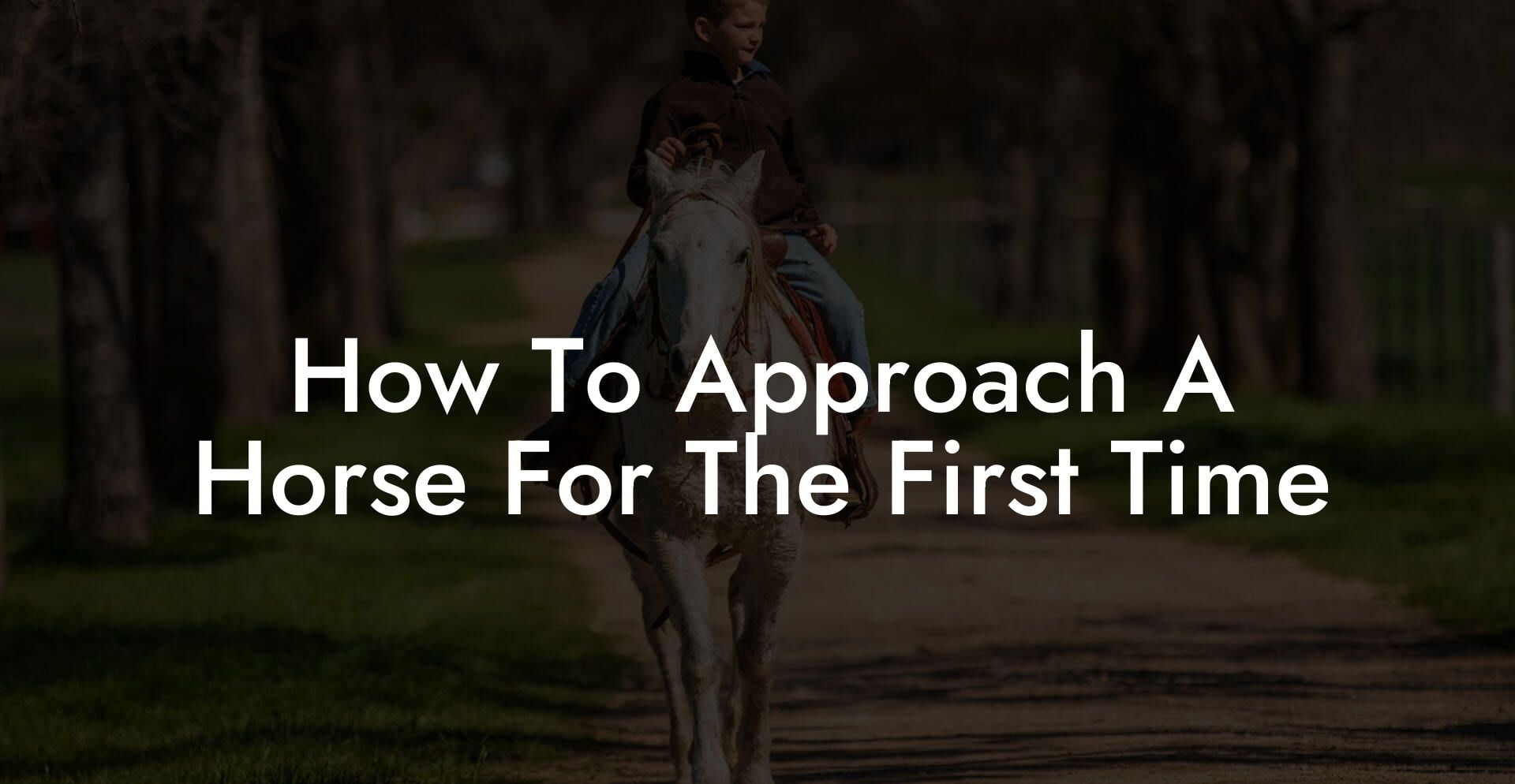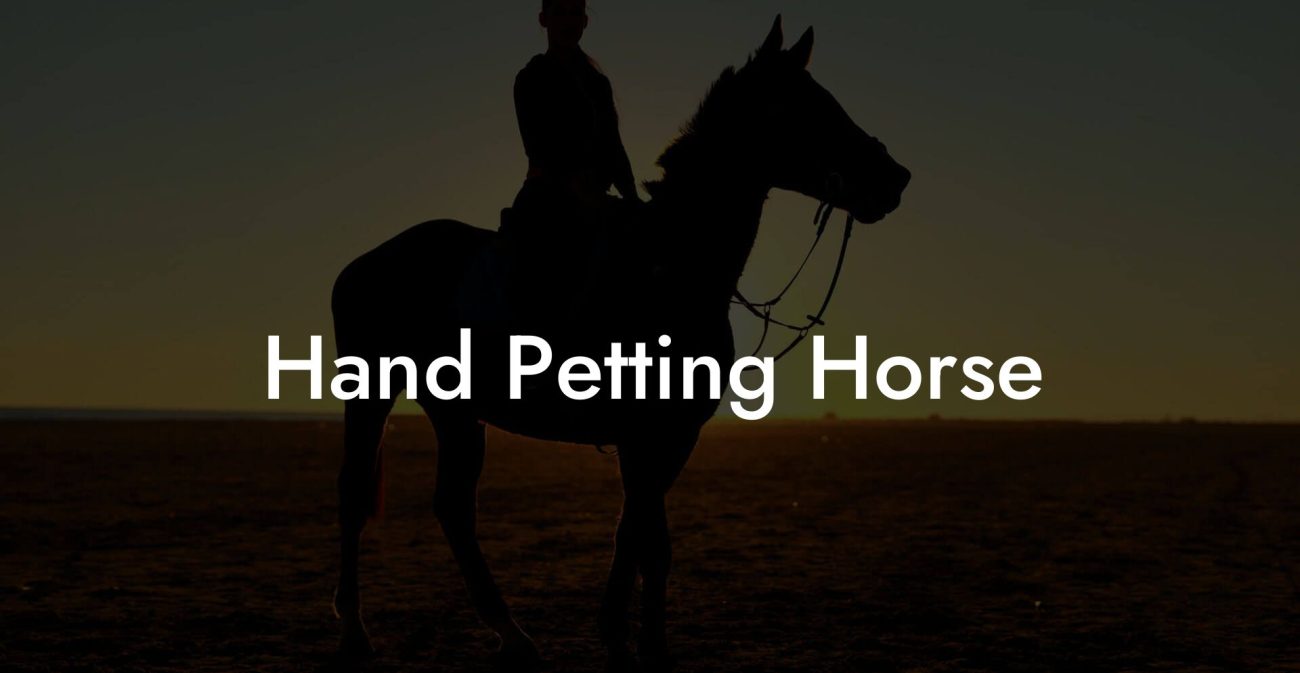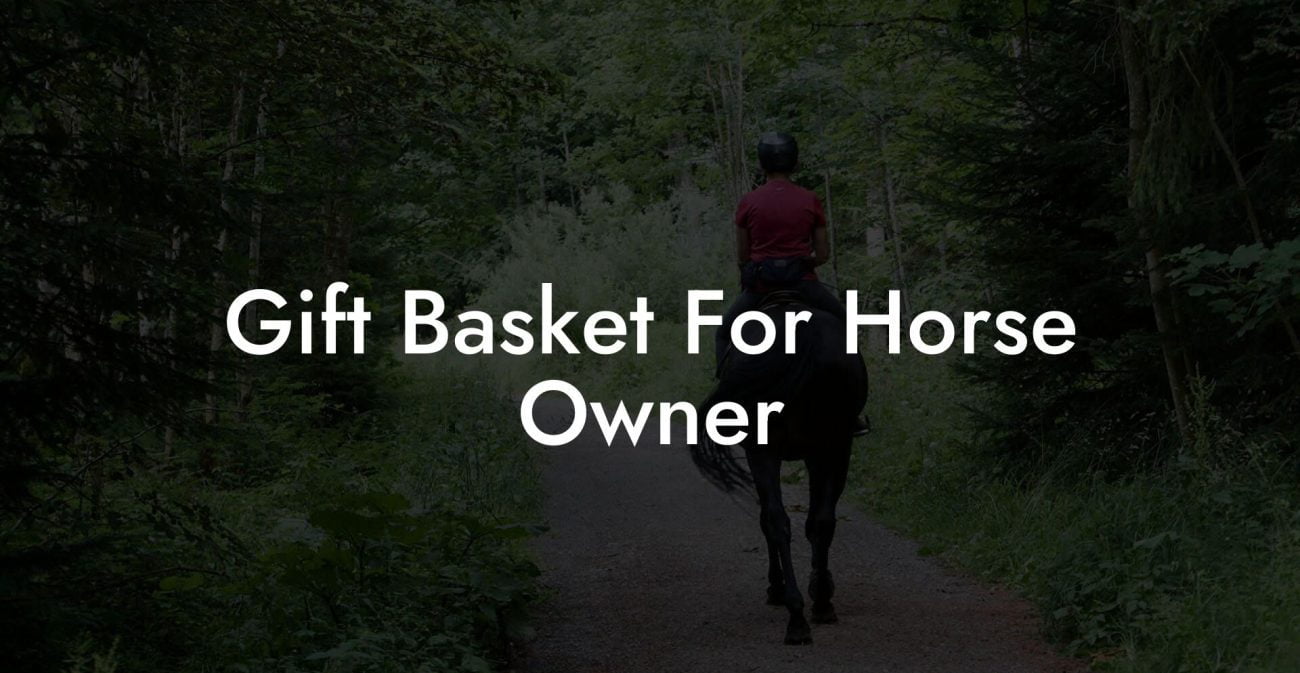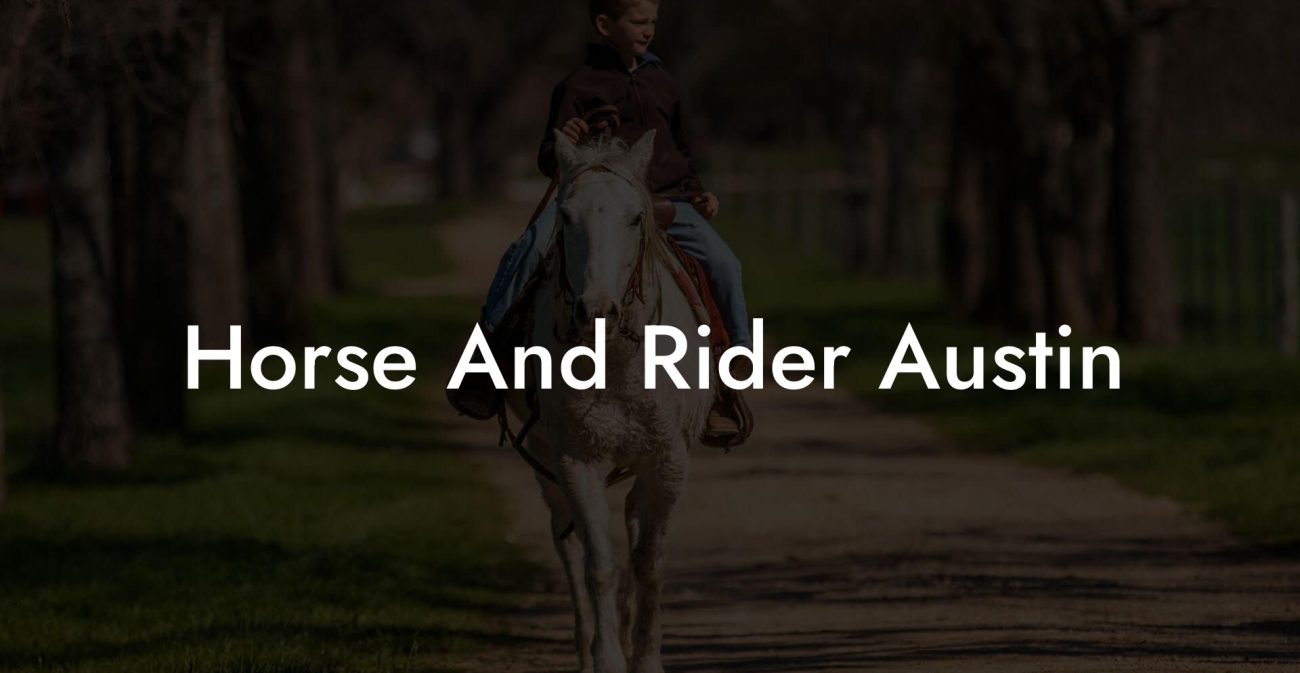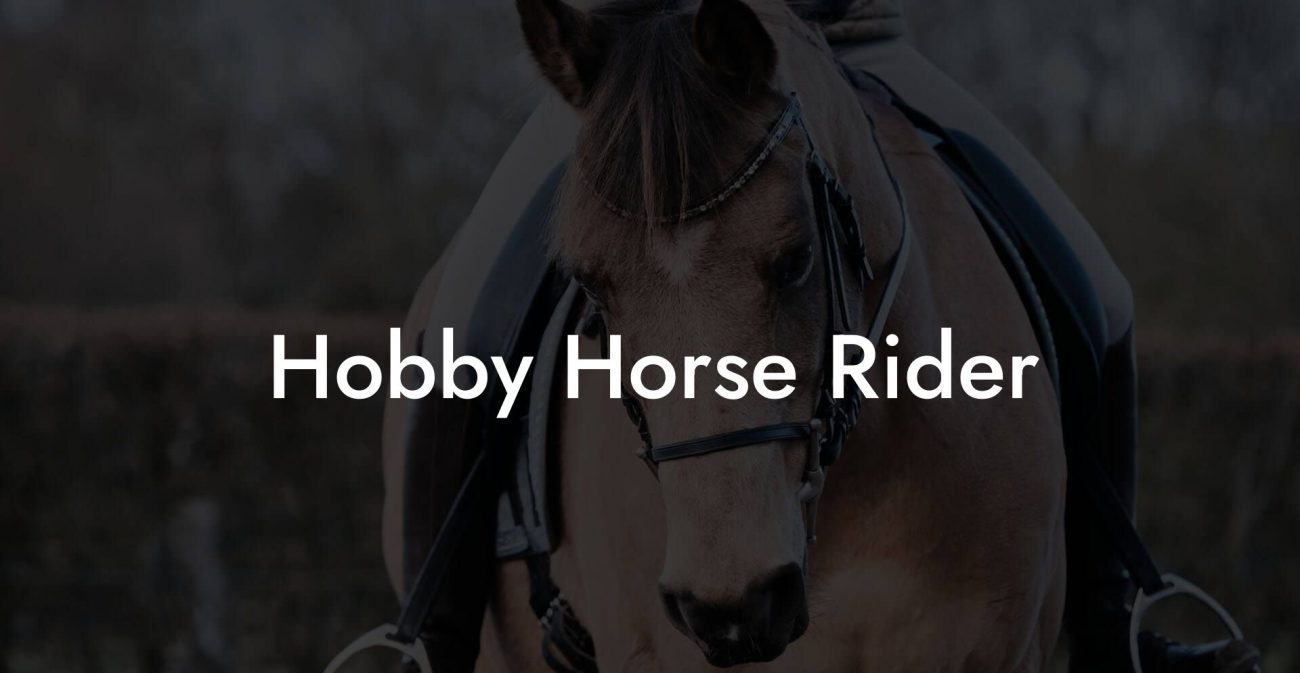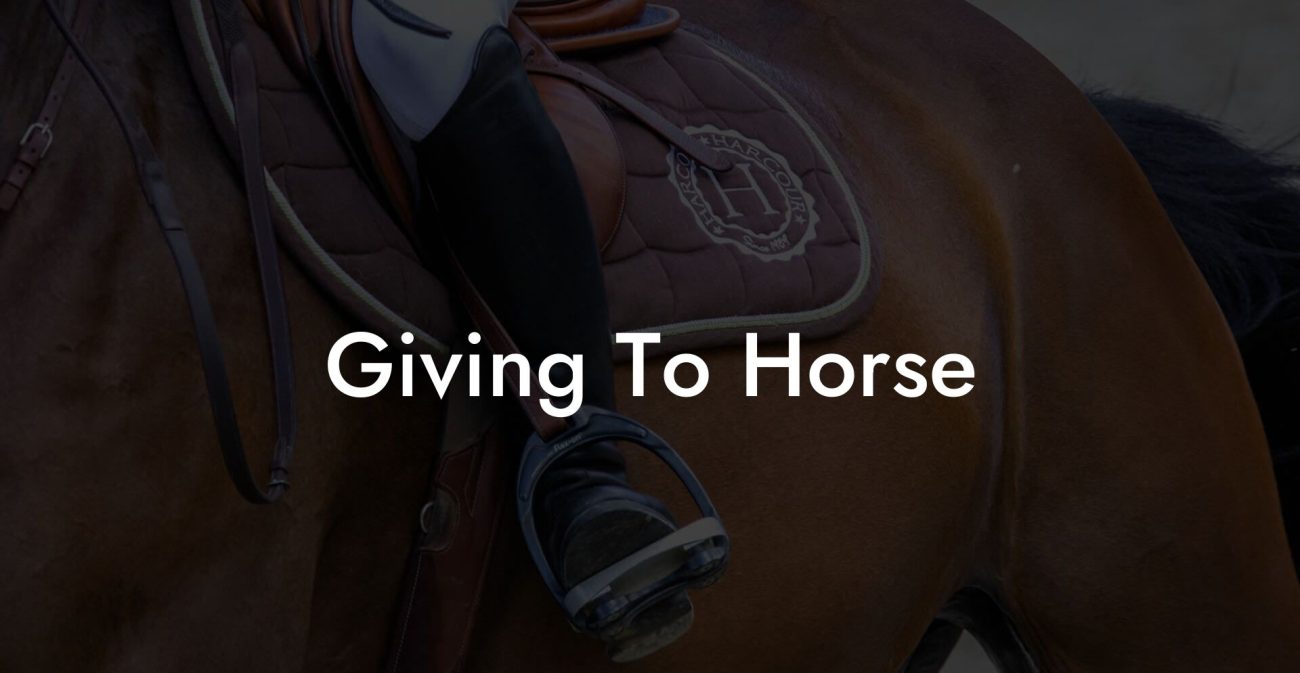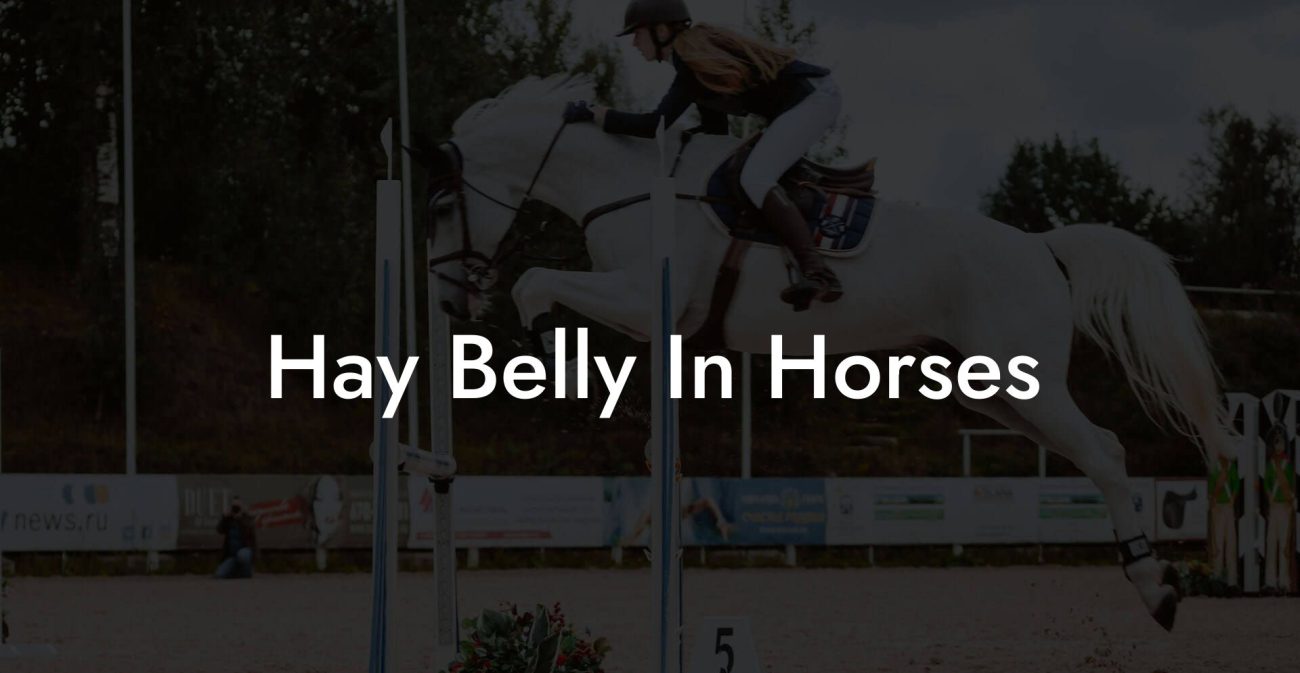There’s a unique thrill in meeting a horse for the very first time, a mix of awe, curiosity, and a dash of adrenaline that turns an ordinary day into an unforgettable adventure. As you stand face-to-flank with these magnificent, four-legged wonders, you quickly learn that every gentle nicker and swish of its tail tells a story. Whether you’re a curious beginner or a Gen-Z equestrian enthusiast looking to get closer to nature, understanding how to approach a horse isn’t just about safety, it’s about forming a genuine connection. Let’s dive into the art and science of horse handling, exploring everything from horse behavior to first-time interactions while keeping it real, relatable, and, yes, a little bit fun.
Quick Links to Useful Sections
- Understanding Horse Behavior: The Foundation of Equestrian Connection
- Preparing Yourself: Mindset, Gear, and Setting the Scene
- How to Approach a Horse: A Step-by-Step Guide to Your First Encounter
- Step 1: Observe from a Distance
- Step 2: Approach Slowly and Confidently
- Step 3: Speak Softly and Use Body Language
- Step 4: Offer Your Hand and Let the Horse Come to You
- Step 5: Respect the Horse’s Space
- Building Trust with Your Equine Buddy: The Art of Connection
- The Dos and Don’ts: Navigating Horse Interactions Like a Pro
- Dos:
- Don’ts:
- Dealing with a Nervous Horse: Calming Techniques That Work
- Creating a Positive Environment for Your First Equine Encounter
- Navigating First-Time Riding and Handling Sessions
- Understanding and Respecting Equine Communication
- Practical Tips and Real-Life Stories from the Equestrian Community
- Anecdote One: The First Time Fail Turned to Success
- Anecdote Two: When Patience Pays Off
- Essential Horse Safety Techniques: Protecting Yourself and the Animal
- Exploring Advanced Equine Interactions: From Grooming to Riding
- How to Communicate with Your Horse: Tips for Non-Verbal Dialogue
- Resources and Community Support: Your Next Steps
- Embracing the Journey: From First Approach to Lifelong Bond
- Integrating Horse Handling with Modern Lifestyle: Tips for Gen-Z and Millennials
- Frequently Asked Questions About Approaching a Horse for the First Time
- Your Journey to Confident and Respectful Equine Interaction
Understanding Horse Behavior: The Foundation of Equestrian Connection
Horses are the original influencers, a blend of grace, power, and sensitivity all wrapped up in a single, breathtaking creature. Before you even think about extending a hand or reaching for a gentle pat, it’s vital to understand that horses communicate in subtle ways. Their body language, ear positioning, tail movements, and overall demeanor provide cues that tell you exactly how they’re feeling.
In equine lingo, a relaxed, forward-moving horse with soft eyes and gently twitching ears signals friendliness and calm. On the flip side, a horse that pins its ears back, flicks its tail aggressively, or displays a sudden burst of energy may be feeling uneasy or, in equestrian terms, “spooked.” Learning to read these cues is your first and most important lesson in horse handling. It’s not just about watching the horse, it’s about entering its world respectfully.
Keywords: horse behavior, equine body language, horse handling, understanding horses
Preparing Yourself: Mindset, Gear, and Setting the Scene
Approaching a horse is as much about preparing yourself as it is about understanding the horse. Start by embracing a calm, confident mindset. Horses are absolute pros at detecting nervous energy, and a jittery human is like a bug in a rug to them. Take a deep breath, channel your inner zen, and remember, you’re here for a positive encounter.
Here are some practical tips to get you geared up for your first equine interaction:
- Dress Appropriately: Wear comfortable clothing that allows freedom of movement. Closed-toe shoes, like riding boots or sneakers with a good grip, are a must. Avoid overly bright colors or flashy patterns that might distract or startle the horse.
- Gather Basic equipment: A grooming brush, halter, and maybe a few treats (if permitted) can ease the process of gaining a horse’s trust. When it comes to first encounters, less is more.
- Know the Environment: Whether you’re at a local stable, farm, or horse trail, assess the surroundings. Look for a calm, fenced area where the horse feels secure. Avoid busy areas to minimize distractions for both you and the horse.
- Keep Your Cool: Remember, you’re a guest in the horse’s world. Staying calm and respectful puts both of you at ease.
Keywords: beginner horse safety, equestrian gear, horse approach tips, first time horse interaction
How to Approach a Horse: A Step-by-Step Guide to Your First Encounter
With your mindset set and your gear in place, it’s time to step into the horse’s world. Approaching a horse might seem daunting if you’ve never done it before, but follow this step-by-step guide and you’ll be on your way to a positive, memorable experience.
Step 1: Observe from a Distance
Start by watching the horse from a safe distance. This allows you to appreciate its behavior without being intrusive. Notice how it moves, how its ears swivel when it hears a noise, and whether it appears relaxed or alert. This initial step is all about assessing whether the horse is open to interaction.
Step 2: Approach Slowly and Confidently
Once you’ve observed and gauged the mood, start approaching slowly. Keep your movements smooth and deliberate, sudden actions can trigger a flight response. Avoid chasing the horse; remember, you’re the guest here. Walk at a pace that lets the horse adjust to your presence.
Step 3: Speak Softly and Use Body Language
Horses are highly attuned to non-verbal cues. Speak in a soft, even tone to announce your intent. A friendly “hello” or gentle hum can be reassuring. Keep your body language open, avoid standing directly in front or making abrupt gestures. Instead, approach from an angle where the horse can see you.
Step 4: Offer Your Hand and Let the Horse Come to You
Once you’re close enough for the horse to notice you, slowly extend your hand with your fingers relaxed. Let the horse come to sniff you if it’s interested. As a rule of thumb, let the horse take the initiative in deciding how close it wants to get. Patience is your friend in these encounters.
Step 5: Respect the Horse’s Space
Not every horse is ready for immediate contact. If the horse backs away or shows signs of discomfort, respect its space. Step back and give it another minute or two. Building trust takes time, and pushing beyond the animal’s comfort zone can set you back in your quest for a genuine connection.
Keywords: how to approach a horse, horse handling steps, equestrian tips, first time horse approach
Building Trust with Your Equine Buddy: The Art of Connection
Trust is the cornerstone of any relationship, and the same holds true for humans and horses. Once you’ve made that initial approach, it’s time to build on that foundation through consistent, respectful interaction.
Start by spending time in the horse’s presence without forcing interaction. Simply being nearby, reading a book or chatting quietly with a friend, can help the horse get used to your presence. Over time, incorporate gentle touching and grooming. When brushing a horse’s coat, use long, soothing strokes. Not only does this help relax the horse, but it also reinforces the idea that you’re a non-threatening presence.
Consider these trust-building tips:
- Consistency: Regular, calm interactions help the horse understand that you’re reliable. Over time, this consistency translates into trust.
- Positive Reinforcement: Use treats and verbal praise to reward calm behavior. Remember, a content horse is more likely to reciprocate warmth.
- Body Language: Mirror relaxed body language. Keeping your movements slow and your posture open encourages the horse to relax as well.
- Time and Patience: Rome wasn’t built in a day, trust with horses takes time. Honor the pace of the horse and let the bond grow organically.
Keywords: building trust with horses, equine trust, horse grooming tips, first time horse meeting
The Dos and Don’ts: Navigating Horse Interactions Like a Pro
A good equestrian connection is built not just on what you do, but also on what you avoid doing. Knowing the dos and don’ts can help you sidestep common pitfalls and ensure that both you and the horse enjoy a stress-free encounter.
Dos:
- Do Approach Calmly: Slow and steady wins the race. Always approach a horse at a gentle pace.
- Do Observe Body Language: Pay attention to the subtle signals a horse is sending through its ears, eyes, and posture.
- Do Build Gradually: Take time to get close, and allow the horse to dictate the pace of your interaction.
- Do Use Soft Tones: A soothing voice reassures the horse that you mean no harm.
- Do Respect Personal Space: Especially during your first encounter, be sure to give the horse enough room to feel secure.
Don’ts:
- Don’t Rush the Process: Avoid hurrying or forcing an interaction; patience is key in equine communication.
- Don’t Make Sudden Movements: Sudden or jerky movements can startle the horse, making it more defensive.
- Don’t Overwhelm with Touch: Resist the urge to immediately pet or hug the horse, which may be misinterpreted as intrusive.
- Don’t Forget Safety: Always stay aware of your surroundings, horses are large animals and require respectful space.
- Don’t Ignore Feedback: If a horse backs off, snorts, or shows stress signals, step back and allow it to readjust.
Keywords: horse approach dos and don’ts, equine safety, first time horse etiquette, respectful horse handling
Dealing with a Nervous Horse: Calming Techniques That Work
Even the most confident horses have moments of nervousness, and when that happens, your reaction is crucial in setting the tone. A nervous horse isn’t a challenge, it’s an opportunity to hone your skills in empathy and calm communication.
Some horses may be skittish due to past experiences, unfamiliar environments, or just an off day. Here’s how you can help soothe a jittery equine:
- Stay Calm and Confident: Your own sense of calm is contagious. Take slow, deep breaths, and move with deliberate ease.
- Use Gentle Touches: If allowed, a gentle pat along the neck or shoulder (keeping a safe distance) can reassure a nervous horse.
- Talk Softly: Engage the horse with gentle, soft-spoken words. Your voice can serve as a comforting presence.
- Avoid Overstimulation: If the horse seems overwhelmed, take a step back. Allow the animal to regain composure at its own pace.
- Provide a Safe Space: Ensure there are no startling distractions nearby, a quiet, enclosed area is ideal for calming anxious equines.
Remember, every horse is different. What works for one might not soothe another, so be ready to adapt your approach as needed.
Keywords: calming nervous horses, equine calming techniques, how to soothe a horse, nervous horse approach tips
Creating a Positive Environment for Your First Equine Encounter
Your surroundings can have a big impact on how a horse perceives your presence. Creating a calm, positive environment is one of the simplest ways to ensure a smooth first encounter. A quiet paddock, a soft field underfoot, and the low hum of nature in the background can do wonders in putting both you and the horse at ease.
Here are some tips for setting the scene:
- Choose the Right Time: Early morning or late afternoon tend to be quieter times at the stables. Fewer distractions mean a better chance at a calm interaction.
- Eliminate Loud Noises: Turn off your phone or set it to silent, and keep conversations to a low murmur so as not to scare the horse.
- Create a Clear Path: Walk in an open space free of obstacles. This not only keeps you safe but also ensures the horse isn’t feeling threatened by unexpected items in its space.
- Stay Patient: Building a positive environment is about giving the horse time to relax. If it takes a moment longer than expected, that’s totally okay.
Keywords: creating a positive horse environment, horse-friendly settings, horse encounter safety, equestrian first encounter
Navigating First-Time Riding and Handling Sessions
Once you’ve mastered the art of approaching and gaining a horse’s trust on foot, you might be wondering how to extend that connection into the realm of riding and deeper handling sessions. Approaching a horse on the ground is one thing, but mounting and riding introduce an entirely new level of interaction.
For many first-timers, the thought of getting on a horse can be both exhilarating and a tad intimidating. But remember, every seasoned equestrian started as a beginner. The key is to transition slowly:
- Start With Ground training: Before mounting, work on basic handling exercises, such as leading, grooming, and simple commands. Ground training builds communication and sets the stage for safe riding.
- Use a Mounting Block: This helps reduce strain on both you and the horse, making the transition into the saddle smoother and safer.
- Get Professional Guidance: If it’s your first time riding, consider taking a lesson from a certified instructor who can provide tailored tips and support in a controlled environment.
- Focus on Communication: Always remember that your horse is an intelligent, sensitive creature. Use gentle pressure, clear cues, and lots of encouragement; you’re not just riding, you’re partnering.
Keywords: first time riding, beginner horse handling, equestrian riding guide, how to ride a horse safely
Understanding and Respecting Equine Communication
Just like people, horses have their own unique ways of communicating. From subtle gestures to obvious signs, every bit of a horse’s body language is a clue to its emotional state. When you’re learning how to approach a horse, understanding these signals is crucial.
Here are some common signals to look out for:
- Ears Pointed Forward: Indicates interest or curiosity. A horse with forward-facing ears is generally open to interaction.
- Ears Pinned Back or Tucked In: A clear sign of discomfort or agitation. In such cases, it’s best to step back and allow the horse to settle.
- Tail Movements: A relaxed, gently swishing tail usually means the horse is calm, while rapid, aggressive tail swishing may indicate irritation.
- Steady Eyes: Soft, steady gazes signal trust and calm, whereas darting or wide-eyed looks often mean the horse is on high alert.
Paying attention to these signals not only improves your safety but also demonstrates respect for the animal’s feelings.
Keywords: equine communication, reading horse signals, horse behavior cues, respectful horse interaction
Practical Tips and Real-Life Stories from the Equestrian Community
Every experienced horse handler has a story about that first nerve-wracking, then ultimately triumphant encounter. Here, we share some practical tips and real-life anecdotes that highlight the ups and downs of learning to interact with these majestic animals.
Anecdote One: The First Time Fail Turned to Success
Jessica, a college student and first-time rider, recalls her initial approach to a gentle mare. “I was so nervous that I ended up standing too close and accidentally startled her. Instead of panicking, I backed off, took a deep breath, and watched from a distance for a while. The next day, I returned with fresh enthusiasm and built trust by simply offering some apples and brushing her mane. Now, I can’t imagine my life without horses!”
Anecdote Two: When Patience Pays Off
Mark, an up-and-coming influencer in the equestrian community, shared his experience of approaching a horse that had a reputation for being skittish. “I learned quickly that persistence without pressure is key. I repeated that the most important thing was to remain calm and in tune with the horse’s body language. Over time, I was able to earn his respect, and what started as a challenging encounter eventually became a cherished friendship.”
These stories remind us that while the journey might begin with some missteps, every encounter is an opportunity to learn and grow, both for you and the horse.
Keywords: equestrian community, equine success stories, horse handling anecdotes, real-life horse interactions
Essential Horse Safety Techniques: Protecting Yourself and the Animal
While the excitement of interacting with a horse is undeniable, safety should always be at the forefront. Horses are large and powerful animals, and even the friendliest can react unexpectedly if they feel threatened. Here are some essential safety practices:
- Always Be Aware of Your Surroundings: Maintain a constant awareness of where the horse is and what might startle it. Avoid high-traffic areas, and be mindful of obstacles in your path.
- Keep a Safe Distance: Until you’ve established trust, it’s important to maintain a respectful distance. This prevents accidental collisions or overwhelming the horse.
- Follow Expert Guidance: Never hesitate to ask for help from a seasoned handler or instructor. Their experience can be your safety net during initial encounters.
- Wear Appropriate Safety Gear: Depending on the situation, a safety helmet and sturdy footwear can provide an extra layer of protection, both in and out of the saddle.
- Know the Emergency Protocols: Familiarize yourself with basic emergency procedures in case something unexpected happens. It’s always better to be prepared.
Keywords: horse safety techniques, equine safety, first time horse handling safety, protective equestrian tips
Exploring Advanced Equine Interactions: From Grooming to Riding
Once you’ve moved past the initial phase of simply approaching a horse, you might want to explore more advanced forms of interaction. For many, this means transitioning from observer to participant by engaging in grooming, leading, and even riding.
Grooming: Grooming is not just a chore on the farm, it’s a key activity for building trust. Use a soft brush and gentle strokes to help keep the horse’s coat clean and its muscles relaxed. It’s a tactile conversation that says, “I care about you.”
Leading Exercises: Once the horse shows signs of comfort, try gentle leading exercises. Walk beside the horse, allowing it to set the pace. This practice is not only a trust-building exercise but also helps you learn to communicate non-verbally.
Riding Lessons: If you’re transitioning to riding, start with short, supervised sessions. Use mounting blocks, secure stirrups, and stay close to an experienced instructor. Riding connects you with the horse in a dynamic way, turning passive admiration into active partnership.
Keywords: horse grooming, equine riding lessons, advanced horse interactions, beginner horse riding tips
How to Communicate with Your Horse: Tips for Non-Verbal Dialogue
Communication with a horse goes beyond words. It’s a dance of subtle gestures, eye contact, and shared silence. For a Gen-Z and millennial audience that thrives on digital communication and face-to-face authenticity alike, learning this non-verbal language can be both fun and profoundly rewarding.
Observe and Mirror: Take a moment to study the horse’s body language. If it’s calm, mirror that calmness through your posture and breathing. Over time, you’ll start to tune into its emotional frequency.
Use Repetition and Patience: Every command or cue requires consistency. Just as social media algorithms reward consistency, horses thrive on repeated patterns. Use the same gesture or word each time to signal the same request.
Respect the Silence: Sometimes, silence and relaxed proximity speak louder than any words ever could. Allow moments of quiet integration where you simply exist together. This silent communication often builds a powerful bond.
Keywords: equine communication, non-verbal horse dialogue, reading horse language, silent bonding with horses
Resources and Community Support: Your Next Steps
Ready to take your newfound knowledge from theory to practice? The journey toward mastering horse handling and building a deep, respectful connection with these majestic creatures is best navigated with community support and trusted resources. There are plenty of clubs, online forums, and local stables where you can ask questions, share your experiences, and even find workshops that dive deeper into equine communication and riding.
Many modern stables offer beginner clinics designed specifically for first-time horse enthusiasts. These clinics often cover everything from the basics of approaching a horse and understanding its behavior, to in-depth riding and grooming classes. Platforms like Instagram, TikTok, and YouTube are also brimming with quick tutorials, behind-the-scenes looks at everyday horsemanship, and personal stories that may inspire you to overcome your initial jitters.
If you’re eager to connect even further, consider joining local equestrian groups or online communities dedicated to horse lovers. Whether you’re looking for advice, tips, or just a supportive ear to share your excitement, surround yourself with those who share your passion for these noble animals.
Keywords: equestrian community, horse care resources, beginner riding classes, horse handling workshops, online equestrian forums
Embracing the Journey: From First Approach to Lifelong Bond
Approaching a horse for the first time is much like embarking on any new adventure, it’s the start of a journey filled with surprises, laughter, and moments of genuine connection. Every handshake, every soft caress, and every shared pause between you and the horse marks the beginning of a bond that could last a lifetime.
While you might feel a mix of trepidation and excitement at the prospect of this new relationship, remember that every expert started as a beginner. Embrace the learning curve with humor and patience. In time, you’ll find that not only do you learn to approach a horse with confidence, but you also unlock a world of self-discovery, personal growth, and a deeper appreciation for nature’s wonders.
So, whether you’re planning your first visit to a stable, considering a weekend retreat in the country, or simply daydreaming about the open fields and the gentle rustle of hay, know that the world of horsemanship is as vast as it is welcoming.
Keywords: lifelong bond with horses, the horse journey, first horse approach, equestrian adventure, building equine relationships
Integrating Horse Handling with Modern Lifestyle: Tips for Gen-Z and Millennials
Let’s be real, in our fast-paced digital world, taking a break to connect with nature can feel like hitting refresh on your soul. For Gen-Z and millennials who are often glued to screens and always on the move, spending time with horses offers a unique opportunity to slow down, disconnect from the noise, and engage in something visceral and real.
Consider these modern tips for integrating horse handling into your lifestyle:
- Document Your Journey: Share your experiences on social media to connect with like-minded enthusiasts. A snapshot of you calmly approaching a horse can inspire others to experience the beauty of equine connections.
- Blend Fitness and Fun: Incorporate horse riding and grooming into your workout routine. It’s a refreshing alternative to the gym, providing both physical activity and mental clarity.
- Embrace Digital Learning: Leverage online tutorials, webinars, and virtual tours of stables to learn more about equine care. Many reputable equestrian professionals offer courses tailored for newcomers.
- Find Local Events: From horse fairs to riding workshops, many communities host events that invite beginners to explore the world of horses without the intimidation of a full-time commitment.
Keywords: modern equestrian lifestyle, Gen-Z horse handling, millennial riding tips, digital horse learning, integrating riding with fitness
Frequently Asked Questions About Approaching a Horse for the First Time
The transition from being a curious beginner to an informed horse handler can bring up a lot of questions. Here are some of the most common queries answered to help guide you along your equine journey:
1. How should I behave when I first approach a horse?
Approach slowly, speak softly, and always let the horse take the lead. Avoid sudden movements, and give the horse a chance to observe you from a distance before coming closer.
2. What are some key body language signs I should watch for?
Look for relaxed ears pointing forward, soft eyes, and a gently swishing tail. If the horse appears agitated (ears pinned back, rapid tail movements, or a tense stance), back off and give it space.
3. Is it safe to pet a horse during my first encounter?
Yes, if the horse is calm and receptive, a gentle pat on the neck or shoulder is usually welcomed. However, always allow the horse to initiate contact, and never force physical interaction.
4. What should I do if the horse seems scared or nervous?
Remain calm, step back, and allow the horse to settle. Use a soft tone to reassure it, and give it time to adjust to your presence.
5. How important is patience when approaching a horse?
Patience is absolutely key. Building trust with a horse takes time and gentle persistence, rushing the process can lead to unnecessary anxiety for both you and the animal.
6. What type of clothing and gear is recommended for a first encounter?
Wear comfortable, non-restrictive clothing and sturdy, closed-toe shoes. Avoid accessories that might startle the horse, and consider bringing along a grooming brush if you plan on grooming.
7. Can I approach any horse or should I ask the owner first?
Always ask the owner or handler for permission before approaching a horse. They know the horse’s temperament best and can advise on the safest way to proceed.
8. How can I tell if a horse trusts me?
Signs of trust include the horse coming closer, accepting your touch, and remaining calm in your presence. A trusting horse may even nudge you gently or lower its head in a friendly gesture.
9. What’s the best way to calm a nervous horse?
Use a calm, confident approach: speak softly, move slowly, and avoid sudden actions. Offering treats or simply standing by patiently can also help soothe a nervous horse.
10. How do I know if I’m ready for riding after approaching a horse on foot?
Once you feel comfortable with ground handling, observing, grooming, and leading, a gradual transition to riding under professional guidance is a natural next step. Always listen to your body and the horse’s cues.
Your Journey to Confident and Respectful Equine Interaction
Embracing the art of approaching a horse for the first time is not just a skill, it’s a journey of self-discovery, trust-building, and a deep admiration for one of nature’s most magnificent creatures. By understanding horse behavior, maintaining a calm and respectful demeanor, and integrating smart safety practices, you’re not only learning how to handle a horse, you’re entering a world where every nuzzle and gentle interaction enriches your life.
From the initial moment of curiosity to the eventual bond of mutual respect, every step of the process is a chance to learn more about communication, empathy, and the delicate balance between caution and courage. As you practice these skills, you become not just a visitor in the horse’s world, but an honored participant in a timeless relationship built on trust, patience, and genuine connection.
Whether you’re dream-chasing at a local stable, following a favorite equestrian after-school program, or simply spending quiet moments in nature, your journey with horses is one that will bring both adventure and self-realization. So step confidently into this new chapter, each encounter, each moment of quiet understanding is a victory in cultivating not just horsemanship, but a deeper connection with the natural world.
Remember, every great equestrian story starts with that very first step of approaching a horse with open-hearted curiosity. So go ahead, take that step, and let the gorgeous world of equine friendship unfold!

